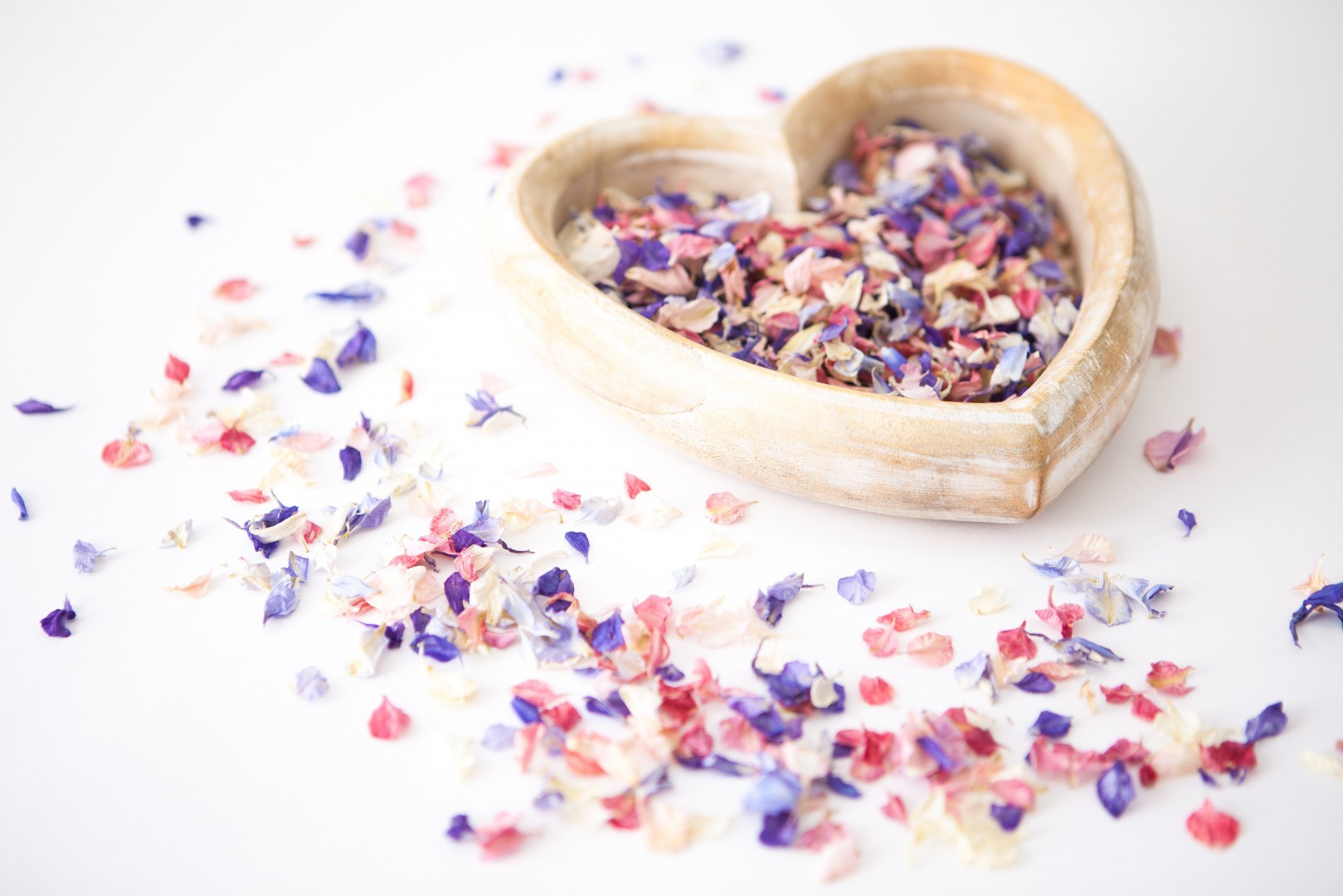In late June or early July, part of the Wyke Manor Estate, nestled in the shadow of Bredon Hill in Worcestershire will be ablaze with the delicate colours of Delphinium blossom as the tall flower spikes come into their own. The sight however is short lived as these fabulous blossoms will need to be hand-picked before their colours fade. Once picked they will go through a unique drying process before being sold as bio-degradable confetti.
The Real Flower Petal Confetti Company was developed by Charles Hudson when two events led him to have a ‘eureka’ moment. Charles had been looking for ways to diversify the 1000acre estate which his family had farmed for over 250 years. Whilst walking past the lych-gate of the Wick village church, he saw the remains of paper confetti blowing on the pavement making an unsightly mess. It is for this reason that many churches and venues ban the use of paper-based confetti and instead of the bride and groom having confetti thrown over them as they walk out of the church, they have to wait until they are beyond church grounds. When Charles subsequently bought his wife a bouquet of flowers which dropped some petals when he got home, his idea of how to use part of their land was born: he would set up a Real Flower Petal Confetti Company.
 The idea took further research as he experimented with different types of flowers to see which had the most suitable blossoms which retained their colour when dried. He also had to develop his own process of drying the petals using fresh air and sunshine. Finally, Delphiniums were chosen. The flower heads are ideal, as the blossom retains its shape and colour when dried and the plants are available in a range of colours. Delphiniums also symbolise swiftness, lightness and strong bonds of love, so are a perfect choice for confetti.
The idea took further research as he experimented with different types of flowers to see which had the most suitable blossoms which retained their colour when dried. He also had to develop his own process of drying the petals using fresh air and sunshine. Finally, Delphiniums were chosen. The flower heads are ideal, as the blossom retains its shape and colour when dried and the plants are available in a range of colours. Delphiniums also symbolise swiftness, lightness and strong bonds of love, so are a perfect choice for confetti.
The process of replanting the fields in different areas of the estate each year, rotating the flower fields with arable crops, is an intensive process. So is the way the blossoms are picked by hand. However, the final result is a bio-degradable and natural confetti loved by all with couples able to select a bespoke colour mix to suit their wedding theme.
As demand grew for the natural blossom confetti, Charles and his team sourced other petals to add to their range. These included wildflowers, hydrangeas, lavender and rose petals. Roses were particularly significant as they are romantic flowers linked with love, passion and romance.
In 2015 the fields of Delphiniums and Cornflowers were opened for the first time to the public for a few days towards the end of June and early July, when the flowers are in full bloom. Visitors can pre-book their ticket to spend a couple of hours walking around the flowers enjoying the magnificent spectacle they provide. There is a pop-up café, too, allowing people to enjoy cake and tea before they head home or to the shop.
When in 2020, it was necessary to replant the flower fields, a 20acre field of sunflowers were added. As they bloom later in the summer, it allowed a second phase of collection. Since the Real Flower Petal Confetti fields were established, a field of over 25acres has been planted to represent the Union Jack, entering the Guinness Book of Records as the world’s largest carpet of flowers.
The tradition of throwing confetti over the bride and groom following their marriage ceremony goes back to medieval times when Italians participating in parades threw various objects, including eggs, mud pellets, pieces of bread, fruit and coins into the gathered crowds. However, in the 1700s candy-coated seeds were used and the word ‘confetti’ is still called ‘coriandoli’ in Italy. The actual word ‘confetti’ is derived from another Italian sweet of sugared almonds, which were handed out as favours at weddings rather than being thrown. In the UK, wedding guests would shower the newlyweds with uncooked rice, wheat or barley as these grains all symbolised fertility. By 1875, the Italians had developed the first paper-based confetti which took the form of small paper discs. This soon became popular in the UK and by 1895 the word ‘confetti’ made it into the Oxford English Dictionary.
If you would like to visit the Real Flower Petal Confetti fields this June and early July, tickets will be available in June from confettidirect.co.uk.
Entry to the fields is from 10 am until 4pm but you need to book your time slot. Whilst under 5s are admitted free of charge, you cannot bring dogs onto the site. Wyke Manor Estate in the village of Wick (WR10 3PA), is reached from the B4084 Evesham to Pershore Road.








